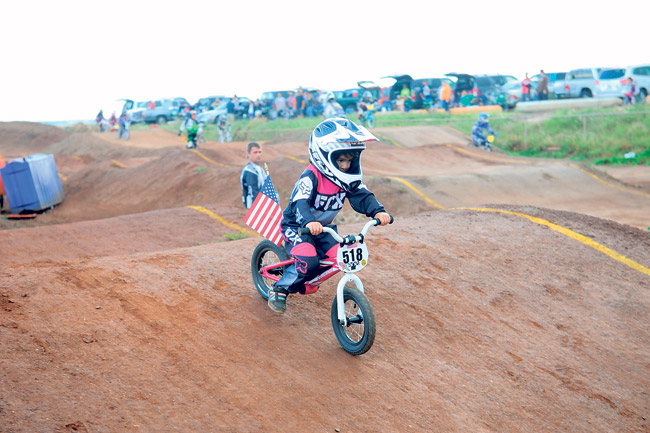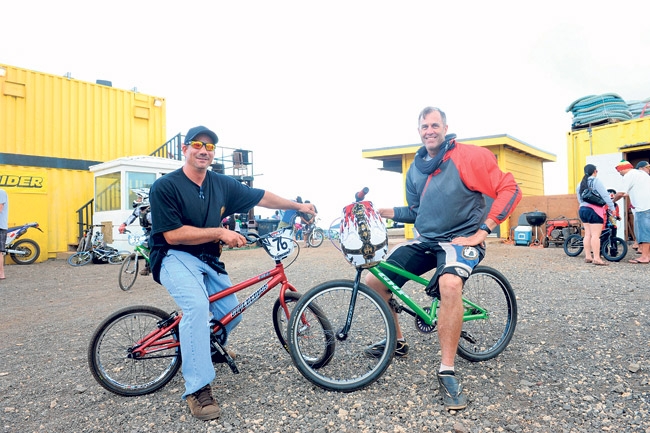Air Time
Standing at the starting gate of the racetrack, an excited crowd of youngsters has gathered, all anxiously awaiting the parade lap – a sign the races are about to begin. The wind occasionally sends dirt flying through the air, but no one cares. The source of this – a racecourse with hills these children soon will jump over with their bicycles – awaits. This is what these children and their families look forward to each Saturday at Island BMX’s Sandbox BMX location on Sand Island.
“It’s a work in progress,” says Kris Moniz, vice president of the board for Island BMX who also is in charge of track maintenance. “It took a lot of countless man-hours, a lot of machine work, a lot of moving of soil, a lot of heart, a lot of dedication and a lot of help from the people out here.”
Now in its fourth year after opening in October 2009, the nonprofit organization boasts approximately 150 members, with races every Saturday (weather permitting), except for a two- to three-month recess that begins in December.
Like most families who frequent the tracks, Keira Tabanera and her family have continued to further involve themselves with Island BMX. Co-operator of the track, event coordinator, secretary of the board and “mama” of the track, Tabanera’s decision to stay was an easy one: The first official race took place on Valentine’s Day, something she made sure never happened again.
“We came on our trial day and we never left – we’ve been here for four years now,” she says, laughing.
Her sons Maka (13) and Rylan (10) are like many of the kids there: difficult to track down amid the excitement. Tabanera remains deeply involved with the organization, much like many of the parents who assist in various tasks to enable things to run smoothly.
This family-involved sport is indicative of Island BMX: It not only operates like a family, it is for families. More importantly, it is for children and teenagers.
“It’s a self-motivated sport, self-propelled, it works on confidence-building in kids; kids learn how to dig deep within themselves to give it the best they’ve got,” says Moniz. “No matter what the outcome is, it’s a good life lesson – things they’re going to need in their daily life.”
BMX racing, which only requires a working bicycle, proper safety wear and the ambition to learn, recently has been garnering more attention throughout the nation after becoming an Olympic sport. Kids seem to take to it naturally, and many are able to advance quickly.
“It is just a race over jumps on your bike, and it really takes nothing to start,” says Jim Drake, president on the board for Island BMX and operator of the track.
With the popularity of the sport picking up, Island BMX is hoping to shape the skills of future professionals – and maybe even an Olympic athlete.
“The goal of the program is to get a good-running, operable facility that really is disciplined on getting kids in condition, getting them healthy and a vision of going to the Olympics maybe one day, or taking it to a different level,” says Moniz.
Additionally, the program also supports the education of its participants. On this particular day, participants are racing for the 2013 Bob Warnicke Memorial Scholarship Fund, a program from Island BMX’s sanctioning body, USA BMX.
“Half of the entry fee ($20) will go to scholarships for kids who are going to go to college or trade school,” says Drake.
According to USA BMX’s website, the Warnicke Scholarship program awarded $27,000 to 20 individual students in 2012.
For children not yet looking to attend college, racers can start as young as age 2 in the once-monthly “Strider races” – a new type of racing USA BMX recently introduced. Toddlers eager to learn BMX racing use their feet instead of pedals to propel their bikes over half of the course, allowing them to get a feel for the sport.
Keiki quickly feel comfortable with it, and Drake says he has seen a child as young as 2 participate in the regular pedal-bike races.
Strider races accommodate children up to the age of 5. The oldest age group that races is for those over the age of 61.
For the kids, it’s mostly about having fun.
“It’s something fun you can do with your friends and you can hang out, and it’s not just to win races; it’s to exercise and have fun,” says Rylan Ingano, Tabanera’s son.
Located next to the ocean, it may not look like much, but every mound of dirt the racers jump over and every operable facility was a donation of either time or materials and, in some cases, both.
“Everybody kind of has a trade where it’s useful to the track, whether they’re a carpenter, plumber, electrician,” says Tabanera. “Whatever it is, we just put their skills to use here and it worked out great.”
The current racetrack (the group rebuilds it every season) took three months to complete. About four guys completed most of the work, with two days being open to the entire community to volunteer.
“None of them has track-building experience, it’s just from watching YouTube videos and going to national events, and researching what other tracks look like,” says Tabanera. “They come up with these ideas and they put this together.”
The culture Island BMX has created for its members runs deep, but it also is welcoming of newcomers looking to get involved.
Kimberly Woolery and her family arrived in Honolulu last September and visited the track at the suggestion of a friend. With her and husband Bill’s minds set on getting the kids involved with karate, they took children Aniela (11) and Riley (10) to the track anyway – and they’ve been there ever since.
“(The kids) took to it because this is such a family atmosphere. All the adults, all the kids were like, ‘Aniela, let’s do this; Riley, let’s work on this,'” Wool-ery says. “It was just unbelievably supportive.”
Woolery already is planning to get more involved with the group, and as young as her children may be, they understand the importance beyond perfecting the sport.
“It’s fun,” Riley says simply. “It’ll bring up your endurance; it’s really social and it’s a healthy activity.”
The positive atmosphere of the track is reflected in each of its participants, and is unique to Island BMX.
With its attendance expanding, Island BMX relies on its membership funds and donations, and hopes to continue to make improvements to the track.
“Probably the biggest thing that we’re working on is the lighting,” says Drake. “We’re squeaking by with what we’ve got, but we’re going to improve that.”
Another addition on Drake’s wish list for the track is viewing stands. The best viewing area right now seems to be from the beds of trucks and other vehicles that arrive early enough to park along the racetrack.
Membership with Island BMX currently costs $60 for the season. Those interested but not yet sure of committing can experience a one-day $1 trial; rentals also are available. Practices are held Monday and Wednesday evenings at the Sand Island track.
For more information, visit islandbmx.org.







